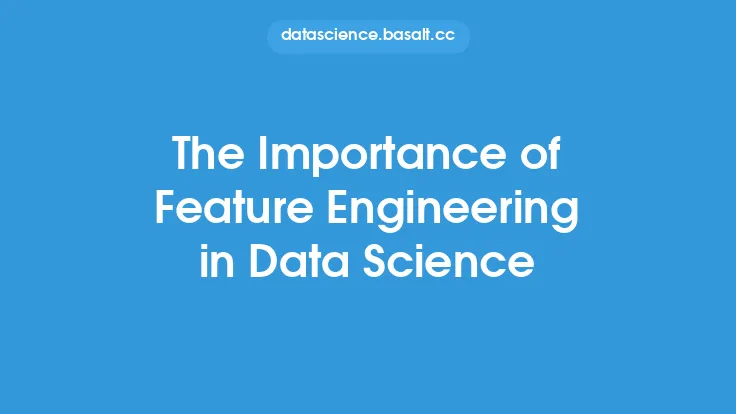The process of extracting valuable insights and patterns from data is a complex and multi-step endeavor, and one of the most critical components of this process is feature engineering and selection. This step is essential in preparing the data for modeling and analysis, as it enables the identification of the most relevant and informative features that will drive the discovery of meaningful relationships and patterns. In the context of data mining, feature engineering and selection are crucial in ensuring that the resulting models are accurate, reliable, and generalizable.
Introduction to Feature Engineering
Feature engineering is the process of selecting and transforming raw data into features that are more suitable for modeling and analysis. This involves using domain knowledge and expertise to identify the most relevant and informative features, as well as applying various techniques to transform and manipulate the data. The goal of feature engineering is to create a set of features that are relevant, informative, and useful for modeling and analysis, while minimizing the impact of noise, outliers, and irrelevant data. Feature engineering is a critical step in the data mining process, as it directly affects the quality and accuracy of the resulting models.
Types of Feature Engineering
There are several types of feature engineering, including feature extraction, feature construction, and feature selection. Feature extraction involves extracting relevant features from the raw data, such as extracting keywords from text data or extracting features from images. Feature construction involves creating new features from existing ones, such as creating a new feature that represents the ratio of two existing features. Feature selection involves selecting a subset of the most relevant and informative features from the available data, with the goal of reducing dimensionality and improving model performance.
Feature Selection Techniques
Feature selection is a critical component of feature engineering, as it enables the identification of the most relevant and informative features. There are several feature selection techniques, including filter methods, wrapper methods, and embedded methods. Filter methods evaluate the relevance of each feature independently, using metrics such as correlation or mutual information. Wrapper methods use a machine learning algorithm to evaluate the performance of different feature subsets, with the goal of identifying the optimal subset. Embedded methods integrate feature selection into the machine learning algorithm itself, such as using regularization techniques to select features.
Dimensionality Reduction Techniques
Dimensionality reduction is a critical component of feature engineering, as it enables the reduction of high-dimensional data to a lower-dimensional representation. There are several dimensionality reduction techniques, including principal component analysis (PCA), singular value decomposition (SVD), and t-distributed Stochastic Neighbor Embedding (t-SNE). PCA involves projecting the data onto a lower-dimensional space using orthogonal transformations, while SVD involves decomposing the data into a set of orthogonal components. t-SNE involves mapping the data to a lower-dimensional space using a non-linear transformation, with the goal of preserving local relationships and structures.
Feature Engineering for Different Data Types
Feature engineering is a critical step in the data mining process, regardless of the type of data being analyzed. For numerical data, feature engineering may involve scaling and normalization, as well as handling missing values and outliers. For categorical data, feature engineering may involve encoding and embedding, as well as handling imbalanced classes. For text data, feature engineering may involve tokenization and stemming, as well as handling stop words and punctuation. For image data, feature engineering may involve extracting features using convolutional neural networks (CNNs), as well as handling variations in lighting and pose.
Best Practices for Feature Engineering
There are several best practices for feature engineering, including using domain knowledge and expertise to inform the feature engineering process, as well as using visualization and exploration techniques to understand the data. It is also important to evaluate the performance of different feature engineering techniques, using metrics such as accuracy and F1 score. Additionally, it is important to consider the interpretability and explainability of the resulting models, as well as the potential for overfitting and underfitting.
Common Challenges in Feature Engineering
There are several common challenges in feature engineering, including handling high-dimensional data, handling missing values and outliers, and handling imbalanced classes. Additionally, feature engineering can be time-consuming and labor-intensive, requiring significant expertise and domain knowledge. Furthermore, feature engineering can be sensitive to the choice of algorithm and hyperparameters, requiring careful evaluation and tuning.
Future Directions in Feature Engineering
There are several future directions in feature engineering, including the development of automated feature engineering techniques, as well as the integration of feature engineering with other components of the data mining process. Additionally, there is a growing interest in using deep learning techniques for feature engineering, such as using CNNs and recurrent neural networks (RNNs) to extract features from images and text data. Furthermore, there is a growing interest in using feature engineering for real-time and streaming data, requiring the development of efficient and scalable algorithms and techniques.





